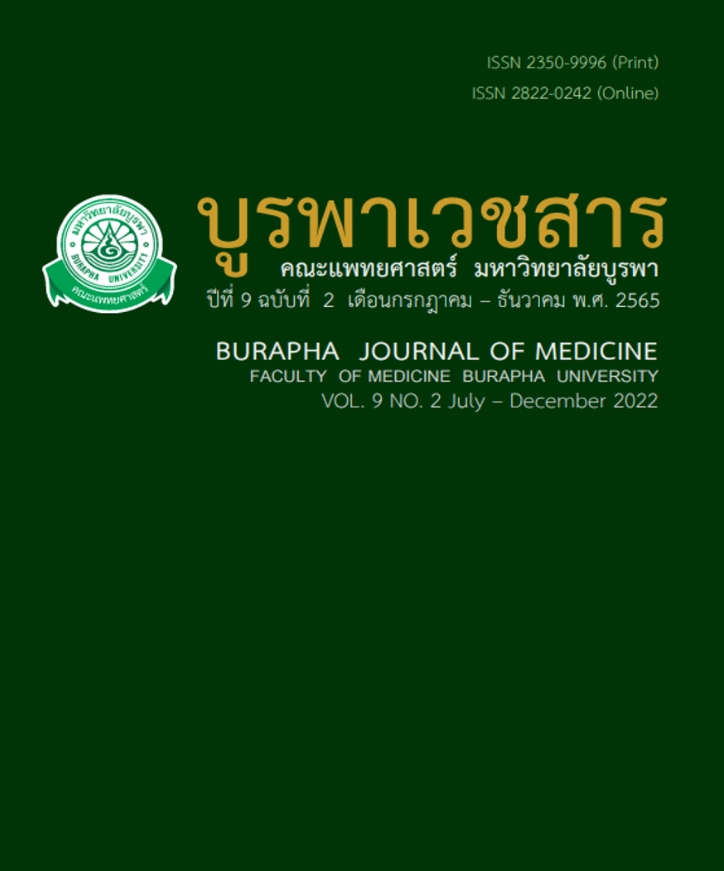ผลทางคลินิกของแนวทางการดูแลทารกแรกเกิดที่มีความเสี่ยงต่อภาวะน้ำตาลต่ำในเลือด
คำสำคัญ:
ทารกแรกเกิด, ภาวะน้ำตาลในเลือดต่ำ, แนวทางการดูแล, ทารกกลุ่มเสี่ยง, เบาหวานขณะตั้งครรภ์บทคัดย่อ
บริบท แนวทางการดูแลเพื่อป้องกันการเกิดภาวะน้ำตาลต่ำในเลือดของทารกกลุ่มเสี่ยงในปัจจุบันมีหลายแนวทางที่แตกต่างกัน
วัตถุประสงค์ เพื่อเปรียบเทียบอุบัติการณ์ของภาวะน้ำตาลต่ำในเลือดแบบมีอาการแสดงก่อนและหลังการใช้แนวทางการดูแลทารกกลุ่มเสี่ยงภาวะน้ำตาลต่ำในเลือดของโรงพยาบาลมหาวิทยาลัยบูรพา
วิธีการศึกษา การศึกษานี้เป็นการวิจัยแบบ Retrospective cohort และ Pre-Post analysis ด้วยการทบทวนเวชระเบียนจากทารกที่เกิดในโรงพยาบาลมหาวิทยาลัยบูรพาตั้งแต่เดือนกรกฎาคม พ.ศ. 2562 ถึงมิถุนายน พ.ศ. 2564 เปรียบเทียบ 2 กลุ่ม คือ กลุ่มหนึ่งปีก่อนและกลุ่มหนึ่งปีหลังใช้แนวทางดังกล่าว แล้วคัดเลือกทารกกลุ่มเสี่ยงเพื่อเปรียบเทียบอุบัติการณ์ของภาวะน้ำตาลต่ำในเลือดแบบมีอาการแสดง ก่อนและหลังการใช้แนวทางดังกล่าว
ผลการศึกษา ทารกแรกเกิดทั้งหมด 187 คน จัดอยู่ในกลุ่มหนึ่งปีก่อนใช้แนวทางฯ 82 คน และหลังใช้แนวทางฯ 105 คน พบว่าอุบัติการณ์ของภาวะน้ำตาลต่ำในเลือดแบบมีอาการแสดงในกลุ่มหลังใช้แนวทางฯต่ำกว่ากลุ่มก่อนใช้แนวทางฯอย่างมีนัยสำคัญ (ร้อยละ 1.9 และ ร้อยละ 9.8 ตามลำดับ RR=0.20, 95
%CI=0.04-0.89, p=0.04) นอกจากนี้ยังพบว่าอุบัติการณ์ของภาวะน้ำตาลต่ำในเลือดแบบไม่แสดงอาการในกลุ่มหลังใช้แนวทางฯต่ำกว่ากลุ่มก่อนใช้แนวทางฯอย่างมีนัยสำคัญ (ร้อยละ 1.9 และ ร้อยละ 15.9 ตามลำดับ RR=0.12, 95%CI=0.03-0.52, p=0.004)
สรุป แนวทางการดูแลทารกกลุ่มเสี่ยงภาวะน้ำตาลต่ำในเลือดของโรงพยาบาลมหาวิทยาลัยบูรพาสามารถลดอุบัติการณ์ของภาวะน้ำตาลต่ำในเลือดแบบมีอาการแสดงและไม่แสดงอาการได้ แนวทางฯนี้ให้ความสำคัญกับการให้นมทันทีแก่ทารกกลุ่มเสี่ยงเพื่อป้องกันการเกิดภาวะน้ำตาลต่ำในเลือดและปรับเกณฑ์การวินิจฉัยภาวะน้ำตาลต่ำในเลือด ซึ่งเป็นความแตกต่างที่สำคัญระหว่างก่อนและหลังใช้แนวทางฯ
คำสำคัญ ทารกแรกเกิด แนวทางการดูแล ภาวะน้ำตาลต่ำในเลือด
เอกสารอ้างอิง
Thompson-Branch A, Havranek T. Neonatal hypoglycemia. Pediatr Rev. 2017; 38: 147-57.
Harris DL, Weston PJ, Harding JE. Incidence of neonatal hypoglycemia in babies identified as at risk. J Pediatr. 2012; 161: 787-91.
McKinlay CJ, Alsweiler JM, Anstice NS, Burakevych N, Chakraborty A, Chase JG, et al. Association of neonatal glycemia with neurodevelopmental outcomes at 4.5 years. JAMA Pediatr. 2017; 171: 972-83.
Shah R, Harding J, Brown J, McKinlay C. Neonatal glycaemia and neurodevelopmental outcomes: a systematic review and meta-analysis. Neonatology. 2019; 115: 116-26.
Cornblath M, Hawdon JM, Williams AF, Aynsley-Green A, Ward-Platt MP, Schwartz R, et al. Controversies regarding definition of neonatal hypoglycemia: suggested operational thresholds. Pediatrics. 2000; 105: 1141-5.
Adamkin DH. Clinical Report—Postnatal Glucose Homeostasis in late-preterm and term infants. Pediatrics. 2011; 127: 575-9.
Thornton PS, Stanley CA, De Leon DD, Harris D, Haymond MW, Hussain K, et al. Recommendations from the Pediatric Endocrine Society for evaluation and management of persistent hypoglycemia in neonates, infants, and children. J Pediatr. 2015; 167: 238-45.
Narvey MR, Marks SD. The screening and management of newborns at risk for low blood glucose. Paediatr. Child Health. 2019; 24: 536-44.
Sangsawang T, Roonghiranwat T. Incidence and risk factor of hypoglycemia in high risk infant in neonatal unit of Prapokklao hospital, Chantaburi. J Prapokklao Hosp Clin Med Educat Center. 2018; 35: 268-76.
Hosagasi NH, Aydin M, Zenciroglu A, Ustun N, Beken S. Incidence of hypoglycemia in newborns at risk and an audit of the 2011 American academy of pediatrics guideline for hypoglycemia. Pediatr Neonatol. 2018; 59: 368-74.
Cordero L, Ramesh S, Hillier K, Giannone PJ, Nankervis CA. Early feeding and neonatal hypoglycemia in infants of diabetic mothers. SAGE Open Med. 2013; 1: 2050312113516613.
McKinlay CJ, Alsweiler JM, Ansell JM, Anstice NS, Chase JG, Gamble GD, et al. Neonatal glycemia and neurodevelopmental outcomes at 2 years. N Engl J Med. 2015; 373: 1507-18.
van Kempen AA, Eskes PF, Nuytemans DH, van der Lee JH, Dijksman LM, van Veenendaal NR, et al. Lower versus traditional treatment threshold for neonatal hypoglycemia. N Engl J Med. 2020; 382: 534-44.
Meneghin F, Manzalini M, Acunzo M, Daniele I, Bastrenta P, Castoldi F, Cavigioli F, Zuccotti GV, Lista G. Management of asymptomatic hypoglycemia with 40% oral dextrose gel in near term at-risk infants to reduce intensive care need and promote breastfeeding. Ital J Pediatr. 2021; 47: 1-8.
Sen S, Andrews C, Anderson E, Turner D, Monthé-Drèze C, Wachman EM. Type of feeding provided with dextrose gel impacts hypoglycemia outcomes: comparing donor milk, formula, and breastfeeding. J Perinatol. 2020; 40: 1705-11.
ดาวน์โหลด
เผยแพร่แล้ว
รูปแบบการอ้างอิง
ฉบับ
ประเภทบทความ
สัญญาอนุญาต
ลิขสิทธิ์ (c) 2022 บูรพาเวชสาร

อนุญาตภายใต้เงื่อนไข Creative Commons Attribution-NonCommercial-NoDerivatives 4.0 International License.



